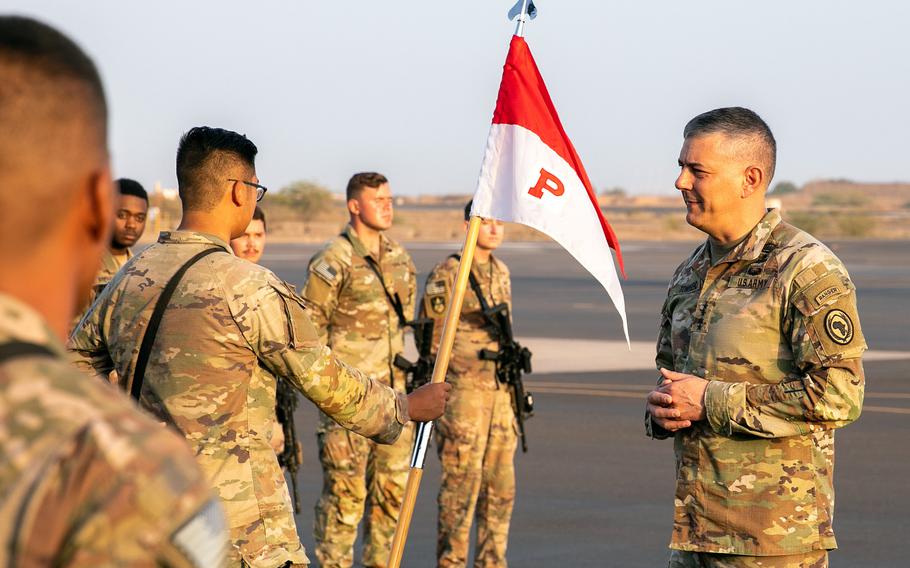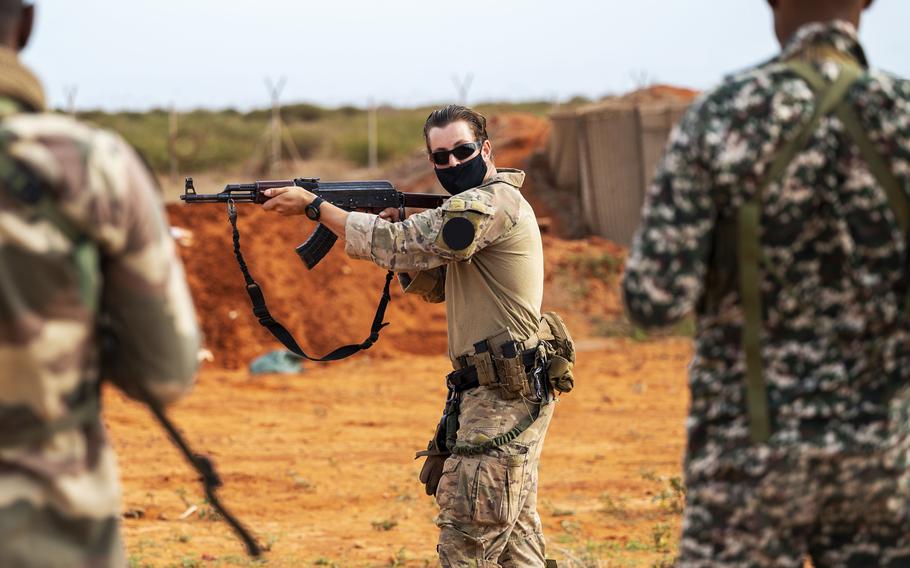
Retired Army Gen. Stephen Townsend, then-commander of U.S. Africa Command, greets soldiers at Camp Lemonnier, Djibouti, in February 2022. The push to get U.S. troops back into Somalia was based in part on an inflated threat assessment from Townsend about the danger from al-Qaida-linked terrorists in the country, according a think tank argued in a report released this week. (Gauret Stearns/U.S. Army)
The push to get U.S. troops back on the ground in Somalia in 2022 was based in part on an inflated threat assessment from U.S. Africa Command about the terrorist danger to the homeland, according to a new report that calls for an updated strategy in the country.
International Crisis Group, an independent multinational think tank, details the behind-the-scenes debate that led the White House to reverse former President Donald Trump’s decision to yank all 700 U.S. troops out of the east African country during the last days of his administration.
The report, released last week by the peace-focused group, calls for more emphasis on nonmilitary means to try to end a long-running conflict that has involved U.S. military airstrikes and troop deployments geared toward building up Somalia’s fledgling armed forces.
Retired Gen. Stephen Townsend, who led U.S. Africa Command at the time of the debate about troop deployments in Somalia, painted a dire picture of the security situation that resulted from Trump’s withdrawal order.
He argued publicly and privately that the al-Shabab group had grown stronger since the AFRICOM mission was relegated to rotating forces in and out of the country, a situation he characterized as “commuting to work.”
“In East Africa, al-Qaida’s al-Shabab remains the greatest threat to U.S. persons and interests in the region as well as the homeland, while undermining peace, security and political progress in Somalia,” Townsend told the Senate Armed Services Committee in 2022.
He went on to say that “if left unchecked, al-Shabab will soon expand beyond Somalia’s borders and become an even greater threat to regional stability and American interests.”

U.S. forces host a range day with the Somali Danab Brigade in Somalia in 2021. The push to get U.S. troops back into Somalia was based in part on an inflated threat assessment about the danger from al-Shabab militants, according to an International Crisis Group report released this week. (Zoe Russell/U.S. Air Force)
The Crisis Group report, which involved interviews with current and past U.S. government officials, added that the plan to get troops back on the ground went mostly unchallenged.
“Despite the sense among some U.S. officials that Townsend may have been inflating the threat, especially to the U.S. homeland, his position faced little if any dissent at the Defense Department,” the report said. “Not even political appointees who otherwise supported scaling back the war on terror vigorously challenged his proposal.”
The result was a return to the military status quo in Somalia, where there are now several hundred troops supporting the country’s decadeslong struggle against Islamic militants.
AFRICOM did not immediately respond Thursday to a request for comment on the report’s findings.
One possible explanation why the decision to deploy again faced so little resistance is that it fit into the Pentagon’s comfort zone: small numbers of troops at a relatively low cost who could help contain a threat from growing beyond the region.
Pentagon and State Department officials ultimately believed that the move to send back the troops was based on it being “the least bad option,” the report said.
While some White House officials were skeptical, the stakes weren’t high enough for serious bureaucratic resistance, the report said.
“There were doubtless several reasons for the diffidence. One was likely that the threat of a terrorist attack weighs heavily on senior leaders, who never want one to happen on their watch,” the report said.
Such an outlook lends itself to a policy that leans on troop deployments “to mitigate even the slightest risk.”
For the U.S., an overarching question is whether a small military footprint in Somalia will lead to the elimination of al-Shabab. The Crisis Group argues that the current approach is almost certain to disappoint in the long run, given the political complexities in Somalia and al-Shabab’s proven resilience.
One factor likely influencing the U.S. approach is the war in Afghanistan, where a counterterrorism campaign expanded into a nation-building effort that ultimately failed.
While leery of investing more in nonmilitary activities, the U.S. has created a balance in Somalia that “right now is lopsidedly militaristic,” the Crisis Group said.
The report urges the U.S. to emphasize political reconciliation efforts among Somalia’s disparate groups and tribal factions.
Also, the U.S. should look for an opening to aid Somalia’s government in settlement talks with the al-Shabab group, as military operations weaken the terrorist organization, it argues.
“A corollary to the broadly accepted analysis that al-Shabaab cannot be defeated militarily is that, at some point, a settlement with the group may offer the best hope of stabilizing the country,” the report said. “Although many officials in Washington recognize that dialogue could be in the cards, they tend to brush off the need for long-term planning toward this end.”